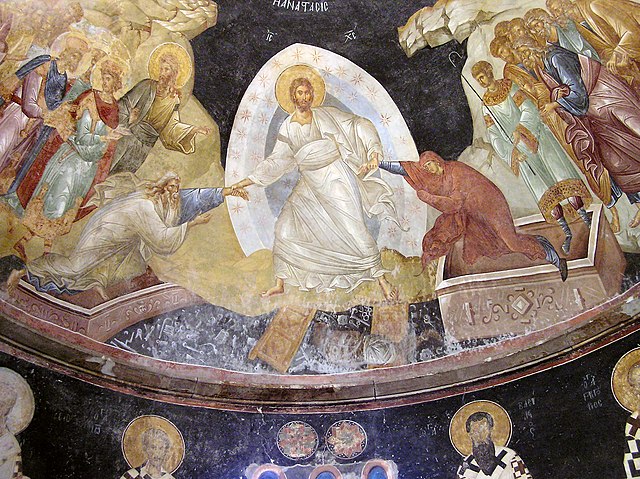In Catholic theology, Limbo is the afterlife condition of those who die in original sin without being assigned to the Hell of the Damned. Medieval theologians of Western Europe described the underworld as divided into three distinct parts: Hell of the Damned, Limbo of the Fathers or Patriarchs, and Limbo of the Infants. The Limbo of the Fathers is an official doctrine of the Catholic Church, but the Limbo of the Infants is not. The concept of Limbo comes from the idea that, in the case of Limbo of the Fathers, good people were not able to achieve heaven just because they were born before the birth of Jesus Christ. This is also true for Limbo of the Infants in that simply because a child died before baptism, does not mean they deserve punishment, though they cannot achieve salvation.
Christ in Limbo (c. 1575) by an anonymous follower of Hieronymus Bosch
Jesus in Limbo by Domenico Beccafumi
Byzantine depiction in the Church of Chora of the resurrection of Christ, raising Adam and Eve who represent all humankind, with the righteous prophets of the Old Testament observing
The Old Testament righteous follow Christ from Hades to heaven (Russian icon).
The afterlife or life after death is a purported existence in which the essential part of an individual's stream of consciousness or identity continues to exist after the death of their physical body. The surviving essential aspect varies between belief systems; it may be some partial element, or the entire soul or spirit, which carries with it one's personal identity.
A depiction of Idris visiting Heaven and Hell from an illuminated manuscript version of the Islamic text Stories of the Prophets (1577)
Georgin François, The 3 Roads to Eternity, 1825.
Judgment of the Dead in Duat
This detail scene from the Papyrus of Hunefer (ca. 1375 B.C.) shows Hunefer's heart being weighed on the scale of Maat against the feather of truth, by the jackal-headed Anubis. The ibis-headed Thoth, scribe of the gods, records the result. If his heart is lighter than the feather, Hunefer is allowed to pass into the afterlife. If not, he is eaten by the waiting Ammit. Vignettes such as these were a common illustration in Egyptian books of the dead.







